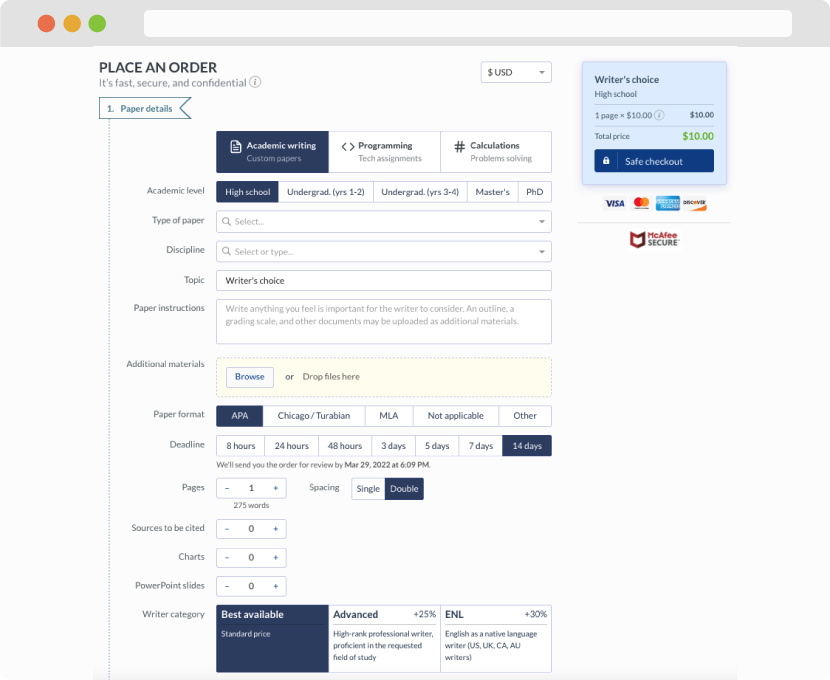This assignment is intended to help you learn to do the following:
What are the ethical issues addressed in this case?
Which issues are ethics issues and which are medical decisions? Explain your answer.
Who needs to be involved in making the necessary decisions to move forward?
Answer the key questions posed in the article, “What factors can make the clinical benefits of restraints outweigh their harms, and how can restraints be effectively and ethically regulated and applied?” Explain your answer.
AMA Journal of Ethics, April 2021 305
AMA Journal of Ethics®
April 2021, Volume 23, Number 4: E305-310
CASE AND COMMENTARY
Should One Kind of Freedom Be Restricted to Promote Another?
Katherine J. Feder, MS, Janice I. Firn, PhD, LMSW, and Ryan Stork, MD
Abstract
Due to restraints’ consequences for personal liberty and dignity, the
threshold to apply restraints is understandably high and heavily
regulated. However, there can be clinical scenarios in which restraint use
can facilitate a patient’s freedom. This article considers such a case and
examines conditions under which using restraints offers therapeutic
benefit for patients with traumatic brain injuries.
Case
Albert is a 33-year-old man who was recently the unrestrained driver in a motor vehicle
accident. He was found unresponsive by emergency medical services with a Glasgow
Coma Scale of 4, which indicates minimal response to defined stimuli. He was intubated
and brought to the nearest hospital, where his workup revealed traumatic brain injury
(TBI) consistent with severe diffuse axonal injury. Like many patients who suffer from
TBI, Albert began to progress through the typical stages of recovery consistent with the
Rancho Los Amigos Levels of Cognitive Functioning, a clinical tool used to describe the
behaviors and cognitive deficits of patients who have experienced TBI.1 It is a 10-level
scale wherein level I indicates no response (coma) with total assistance required and
level X indicates purposeful and appropriate response with modified independence (ie,
able to function independently with compensatory devices or cognitive strategies), with a
spectrum of progression in-between.1 After 2 weeks in the intensive care unit, Albert
stabilized and was transferred to a small inpatient rehabilitation unit for rehabilitation of
his cognitive deficits, poor coordination, and right-sided hemiparesis.
During this time, Albert became agitated, restless, hyperactive, confused, and engaged
in nonpurposeful behavior, consistent with level IV of the Rancho scale.1 The care team
discussed activities on the unit that would allow Albert to channel his restlessness,
thereby aiding his recovery. Permitting Albert to engage in activities outside of his room
would provide an outlet for his restlessness and theoretically prevent an escalation of
his agitation due to his lying in bed for long periods of time. However, given his
disorientation (ie, his inability to remember that he cannot ambulate safely without
assistance), increased fall risk due to poor balance and right-sided hemiparesis, and
motor restlessness, he would require the use of a lap-belt and wheelchair to minimize
potential harms to himself when moving around outside of his room. The staff felt
journalofethics.org 306
uncomfortable using any type of restraint for an indication other than that with which
they were familiar due to the scrutiny applied to restraint use. They wondered how to
balance Albert’s rehabilitation goals and safety needs within the existing regulatory
framework.
Commentary
All individuals have a fundamental right to control their own bodies. Use of physical
restraints is controversial, as restraints inhibit physical movement. The use of restraints
is a reactive measure, permitted only in the absence of any effective alternative to
protect patients from harming themselves or others. Restraint use in health care
settings is governed by federal law,2 state law, and the Joint Commission3 and is
influenced by hospital policy, American Medical Association guidelines,4 and the Centers
for Medicare and Medicaid Services.5 These regulations specify that the least restrictive
effective restraint is to be used for the least amount of time and that its use to restrain a
particular patient must be regularly evaluated.2 In order to receive federal funding
through Medicare and Medicaid, hospitals must comply with these guidelines and laws.5
Any locally developed policies must consider both national and state codes.
Although these regulations apply the same evaluation to all restraints, in effect there is
a range of restraint modalities that limit liberty to varying degrees and that might have
alternate uses in the clinical space. Here, we consider how a one-size-fits-all approach
can be a disservice to patients and to caregivers when trying to optimize treatment of
specific clinical conditions. Specifically, patients with TBI have predictable progressions
over the course of recovery. Although progression through all 10 levels of the Rancho
scale is variable and patient specific, each level is marked by clear characteristics that
are readily assessed via physical and neurological exam by trained clinicians. Many
patients with TBI progress through level IV, which is characterized by confusion and
agitation; patients who make it to this stage will likely progress through it, but the length
of time spent at each level will vary depending on the severity of the injury. It is not
unusual for a patient with TBI to spend 1 to 2 weeks in a state of confusion and
agitation, the treatment of which includes having outlets for restless energy. To provide
these outlets safely, many rehabilitation hospitals with specialized TBI rehabilitation
programs employ the use of lap-belts, enabling patients with TBI at level IV of the
Rancho scale to leave their rooms and engage in group or physical activities in a manner
that reduces fall risk. While this topic is empirically underexplored and relies heavily on
expert opinion, in the experience of the third author (R.S.), which is consistent with the
literature, these patients have shorter length of stay, greater likelihood of discharge to
less restrictive environments, and improved clinical outcomes.6,7,8 This commentary
considers ways in which restraints can be viewed as tools to support interdisciplinary
best practices for patients with certain clinical conditions like Albert’s, what factors can
make clinical benefits of restraints outweigh their harms, and how restraints can be
effectively and ethically regulated and applied.
Context-Specific Reframing of How We Use Restraints
When approaching any given medical intervention, health care professionals weigh the
risks and benefits of that intervention and the likelihood of it achieving the intended
outcome in relation to their patient’s condition. Rather than continuing to view all
restraints as restrictive and reactive measures to restrain and limit patient movement,
we suggest thinking more holistically about how certain types of restraint may facilitate
greater physical freedom in some ways while limiting it in others. The Joint Commission
already recognizes how a clinician’s intended use of equipment, such as bed rails,
https://journalofethics.ama-assn.org/article/shackling-and-separation-motherhood-prison/2013-09
https://journalofethics.ama-assn.org/article/shackling-and-separation-motherhood-prison/2013-09
AMA Journal of Ethics, April 2021 307
affects whether it is considered as a restraint. Specifically, the Accreditation Manual for
Hospitals states: “if the intent of raising the side rails is to prevent a patient from
voluntarily getting out of bed or attempting to exit the bed, the side rails would be
considered a restraint” but that “if the intent of raising the rails is to prevent the patient
from inadvertently falling out of bed, then it is not considered a restraint.”3 We propose
that lap-belts be evaluated over the range of their uses similarly to bed rails, based on
their intended purpose as well as the patient’s best interests. Lap-belts would be used
to prevent patients with TBI like Albert, who have progressed to level IV of the Rancho
scale, from accidentally falling out of their wheelchairs or injuring themselves due to
their disorientation and significant fall risk.
While the use of a lap-belt restricts patients’ freedom of movement by preventing them
from getting up from their wheelchair and effectively restrains them in some ways, it
facilitates patients’ freedom of movement by enabling them to safely navigate their
environment and engage in activities to expel restless energy. Consider Albert’s scenario
in which he is in a state of posttraumatic confusion (ie, unable to remember that he
cannot get out of bed), restless, and has the potential for aggressive behavior. He does
not have the ability to leave his room whenever he would like. His motor impairments
are severe enough that staff (such as a bedside attendant) cannot safely ambulate the
patient when he attempts to get out of his bed. This creates a scenario wherein Albert
may be encouraged to stay in his bed, resulting in increased isolation and immobility,
further escalating his restlessness. Utilizing a lap-belt, however, would allow him to leave
his room when he would like with only near supervision of the patient attendant. He
would be able to self-propel the wheelchair with his feet and explore his environment,
effectively expanding his ability to interact with his surroundings as he so chooses. This
can reasonably be seen as compassionate, so we suggest that a decision to use lap-
belts based on balancing freedoms facilitated against freedoms curtailed is one that
looks to motivate compassion.
Autonomy and Dignity
While some may argue that restraint use violates patient autonomy, patients suffering
from symptoms of TBI are not acting with intention, nor do they possess meaningful
understanding of their environment.9,10 While they may be able to express preferences
through their actions, they do not have the ability to truly act autonomously or provide
informed consent. As they do for other clinical interventions for patients who lack
decision-making capacity, physicians should obtain informed consent from the patient’s
surrogate decision maker. This process would include explaining why the lap-belt is
recommended, the benefits and risks associated with its use, alternative options, and
the scope of activity and duration for which it will be used.10,11,12
The other critique of restraint use often falls into the category of dignitary harms—
specifically, that the use of any restraint limits physical movement and therefore
restricts a basic human right and liberty. However, when one weighs patients’ ability to
leave their room and engage in activity while secured with a lap-belt against their
remaining in bed, the latter can be seen as posing a greater harm by effectively
environmentally restraining patients with TBI to their rooms all day, hindering recovery.12
Thus, lap-belt use in specific contexts with the consent of the patient’s surrogate
addresses suffering and promotes recovery, making it the more compassionate choice.
https://journalofethics.ama-assn.org/article/sliding-scale-shared-decision-making-patients-reduced-capacity/2020-05
https://journalofethics.ama-assn.org/article/sliding-scale-shared-decision-making-patients-reduced-capacity/2020-05
journalofethics.org 308
Regulation and Application
Like other medical interventions, lap-belt use would be limited to specific clinical
indications in which it might confer benefit with authorization of the surrogate. It would
be helpful to have a predefined set of criteria to help identify when using a lap-belt might
be appropriate. A specialized clinician would evaluate whether the patient meets these
criteria—and, if at any point the risks outweigh the benefits, the use of the lap-belt
should be discontinued.
In rehabilitation hospitals, removal of restraints is typically a multidisciplinary decision
based on observations from nurses, the therapy team, and neuropsychologists who are
closely monitoring the patient’s motor and cognitive recovery.13,14 Open communication
among members of the interdisciplinary care team, access to advanced care clinicians,
and correct application and positioning and frequent monitoring of lap-belts would be
imperative to ensure that the lap-belts are used as intended, thus minimizing or
preventing physical harms such as asphyxiation, increased agitation, or discomfort.15 If,
at any point, the burden of the lap-belt outweighed its benefit, it could be discontinued.
As patients with TBI would be engaging in activities that require supervision, such as
moving around the hospital in a wheelchair or engaging in group activities, health care
professionals would be readily available to identify if the lap-belt needs to be removed.
Consistent with medication administration or services rendered, clinicians would
document all use of the lap-belts.
Conclusion
By reframing lap-belts as a type of restraint that can facilitate freedom rather than
purely restrict it for patients with TBI, we have an additional way to promote patient
interests and well-being.
References
1. Lin K, Wroten M. Ranchos Los Amigos. In: StatPearls. StatPearls Publishing;
2019. Updated August 30, 2020. Accessed June 25, 2020.
https://www.ncbi.nlm.nih.gov/books/NBK448151/
2. 42 CFR §482.13(e) (2021).
3. Joint Commission. Standard FAQs: restraint and seclusion—enclosure beds, side
rails and mitts. Updated June 29, 2020. Accessed February 18, 2021.
https://www.jointcommission.org/en/standards/standard-faqs/critical-access-
hospital/provision-of-care-treatment-and-services-pc/000001668/
4. American Medical Association. Opinion 1.2.7 Use of restraints. Code of Medical
Ethics. Accessed September 11, 2020. https://www.ama-assn.org/delivering-
care/ethics/use-restraints
5. Quality, safety, and oversight—certification and compliance. Centers for
Medicare and Medicaid Services. Revised January 10, 2018. Accessed February
18, 2021. https://www.cms.gov/Medicare/Provider-Enrollment-and-
Certification/CertificationandComplianc
6. Luauté J, Plantier D, Wiart L, Tell L. Care management of the agitation or
aggressiveness crisis in patients with TBI. Systematic review of the literature and
practice recommendations. Ann Phys Rehabil Med. 2016;59(1):58-67.
7. Flanagan SR, Elovic EP, Sandel ME. Managing agitation associated with
traumatic brain injury: behavioral versus pharmacologic interventions? PM R.
2009;1(1):76-80.
https://journalofethics.ama-assn.org/article/surgery-shackles-what-are-surgeons-obligations-incarcerated-patients-operating-room/2017-09
https://www.ncbi.nlm.nih.gov/books/NBK448151/
https://www.jointcommission.org/en/standards/standard-faqs/critical-access-hospital/provision-of-care-treatment-and-services-pc/000001668/
https://www.jointcommission.org/en/standards/standard-faqs/critical-access-hospital/provision-of-care-treatment-and-services-pc/000001668/
https://www.ama-assn.org/delivering-care/ethics/use-restraints
https://www.ama-assn.org/delivering-care/ethics/use-restraints
https://www.cms.gov/Medicare/Provider-Enrollment-and-Certification/CertificationandComplianc
https://www.cms.gov/Medicare/Provider-Enrollment-and-Certification/CertificationandComplianc
AMA Journal of Ethics, April 2021 309
8. Ripley DL, Driver S, Stork R, Maneyapanda M. Pharmacologic management of
the patient with traumatic brain injury. In: Eapen BC, Cifu DX, eds. Rehabilitation
After Traumatic Brain Injury. Elsevier Health Sciences; 2019:133-163.
9. Beauchamp TL, Childress JF. Principles of Biomedical Ethics. 6th ed. Oxford
University Press; 2009.
10. Crutchfield P, Gibb TS, Redinger MJ, Ferman D, Livingstone J. The conditions for
ethical application of restraints. Chest. 2019;155(3):617-625.
11. McSherry B. Regulating seclusion and restraint in health care settings: the
promise of the Convention on the Rights of Persons with Disabilities. Int J Law
Psychiatry. 2017;53:39-44.
12. Gunawardena R, Smithard DG. The attitudes towards the use of restraint and
restrictive intervention amongst healthcare staff on acute medical and frailty
wards—a brief literature review. Geriatrics (Basel). 2019;4(3):50.
13. Schleenbaker RE, McDowell SM, Moore RW, Costich JF, Prater G. Restraint use
in inpatient rehabilitation: incidence, predictors, and implications. Arch Phys
Med Rehabil. 1994;75(4):427-430.
14. American Academy of Physician Assistants. Joint Commission removes “licensed
independent practitioner” term from restraint and seclusion standards. New
Central. March 6, 2020. Accessed June 25, 2020. https://www.aapa.org/news-
central/2020/03/joint-commission-removes-licensed-independent-practitioner-
term-from-restraint-and-seclusion-standards/
15. Chaves ES, Cooper RA, Collins DM, Karmarkar A, Cooper R. Review of the use of
physical restraints and lap belts with wheelchair users. Assist Technol.
2007;19(2):94-107.
Katherine J. Feder, MS is a fourth-year medical student at the University of Michigan
Medical School in Ann Arbor, where she is also a predoctoral ethics fellow at Center for
Bioethics and Social Sciences in Medicine. She received a BA in English literature from
Williams College and an MS in bioethics from Columbia University. She is interested in
applied ethics as well as ethics education.
Janice I. Firn, PhD, LMSW is a social worker and clinical ethicist in the Department of
Learning Health Sciences and the Center for Bioethics and Social Sciences in Medicine
at the University of Michigan Medical School in Ann Arbor. In her roles, she responds to
ethics consultation requests, facilitates proactive ethics rounds, and participates in
interprofessional ethics education at the undergraduate, graduate, and professional
levels across the medical and academic campuses. She is also involved in a number of
ethics-related research, caregiver wellness, and quality improvement and assurance
initiatives.
Ryan Stork, MD is an assistant professor of physical medicine and rehabilitation at the
McGovern Medical School at the University of Texas Health Science Center at Houston.
In his role, he provides consultation services for the rehabilitation needs of patients with
traumatic brain injury at Memorial Hermann-Texas Medical Center. He is also an
attending physician at TIRR Memorial Hermann, where he focuses primarily on brain
injury rehabilitation.
https://www.aapa.org/news-central/2020/03/joint-commission-removes-licensed-independent-practitioner-term-from-restraint-and-seclusion-standards/
https://www.aapa.org/news-central/2020/03/joint-commission-removes-licensed-independent-practitioner-term-from-restraint-and-seclusion-standards/
https://www.aapa.org/news-central/2020/03/joint-commission-removes-licensed-independent-practitioner-term-from-restraint-and-seclusion-standards/
journalofethics.org 310
Citation
AMA J Ethics. 2021;23(4):E305-310.
DOI
10.1001/amajethics.2021.305.
Conflict of Interest Disclosure
The author(s) had no conflicts of interest to disclose.
The people and events in this case are fictional. Resemblance to real events or to
names of people, living or dead, is entirely coincidental. The viewpoints expressed
in this article are those of the author(s) and do not necessarily reflect the views and
policies of the AMA.
Copyright 2021 American Medical Association. All rights reserved.
ISSN 2376-6980
Essay Writing Service Features
Our Experience
No matter how complex your assignment is, we can find the right professional for your specific task. Achiever Papers is an essay writing company that hires only the smartest minds to help you with your projects. Our expertise allows us to provide students with high-quality academic writing, editing & proofreading services.
Free Features
Free revision policy
$10Free bibliography & reference
$8Free title page
$8Free formatting
$8How Our Dissertation Writing Service Works

First, you will need to complete an order form. It's not difficult but, if anything is unclear, you may always chat with us so that we can guide you through it. On the order form, you will need to include some basic information concerning your order: subject, topic, number of pages, etc. We also encourage our clients to upload any relevant information or sources that will help.
Complete the order form
Once we have all the information and instructions that we need, we select the most suitable writer for your assignment. While everything seems to be clear, the writer, who has complete knowledge of the subject, may need clarification from you. It is at that point that you would receive a call or email from us.
Writer’s assignment
As soon as the writer has finished, it will be delivered both to the website and to your email address so that you will not miss it. If your deadline is close at hand, we will place a call to you to make sure that you receive the paper on time.
Completing the order and download